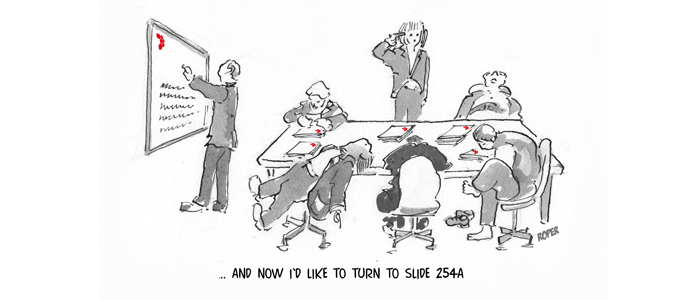Does it sometimes feel as if you spend all day in meetings, yet any real work has to be done outside them? Here are four ways to turn this around and make your meetings more productive.
The real problem is that your meetings aren’t really snappy or productive enough. Of course well-run meetings are essential to getting work done in the modern world. Every project worth achieving takes two or more people to achieve it, and there is no more efficient way of getting a group of people to produce work quickly and effectively than getting them together to brainstorm, make a decision, plan the project and implement it. Just imagine trying to achieve all that by sending emails to and fro instead. But meetings in organisations are often so badly run that this is what people end up trying to do.
So what’s wrong with our meetings and what are the essential tips for running them so that instead of making work and taking up time, they actually get work done and use that time effectively?
- The wrong people are invited to meetings, in the mistaken belief that this will make sure everyone is informed and bought-in to every decision. It’s a recipe for a room full of bored people who would rather be elsewhere, not listening properly and getting in the way of snappy decision-making
Tip no. 1: Only invite essential decision-makers to the meeting. Inform everyone else by communicating with them quickly and clearly in your usual team meetings (you do hold these, don’t you?)
- Everything you might possibly want to talk about is shoehorned into the agenda, so it ends up 15 or 20 items long. And all that’s written down is a topic, so those who come to the meeting are primed to ramble around the subject instead of preparing themselves to communicate only the information that is essential for a decision to be made.
Tip no. 2: Keep agendas short and write them in the form of specific measurable objectives: ‘a decision on…’, ‘next steps in xxx project to be decided and allocated’, ‘ideas for our next campaign to be brainstormed and shortlisted’ etc. Might this mean you have to have more frequent meetings? Yes, but they will be shorter and more targeted, and much of the work that needs doing will be done in the meeting itself.
- Lengthy minutes are taken but take days or even weeks to be written up and circulated so you’ve forgotten what it was you decided and end up going over old ground in the next meeting.
Tip no. 3: During the meeting, note down only action points, who is to take accountability for them and a deadline date. Produce these during the meeting and circulate them before everybody leaves (another job that won’t have to be done after the meeting). You can write them on a flipchart, photograph it and share the photograph, hand write and photocopy them or type them on a laptop and email them immediately. Whoever said meeting notes need fancy formatting?
- People turn up late, get distracted, talk among themselves and don’t listen during meetings, meaning you have to repeat yourself, get into argumentative loops or run out of time.
Tip no. 4: Agree a set of simple groundrules for running all your meetings, including starting and finishing on time, switching off mobile gadgets, listening to each other and not interrupting etc.
Use these four simple tips and you’ll transform your meetings into productive use of your time, as well as saving a whole load of time outside meetings that you used to send duplicating effort and trying to remember what on earth it was you decided in them!

